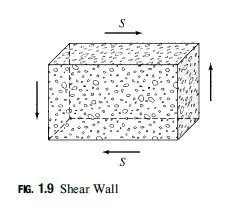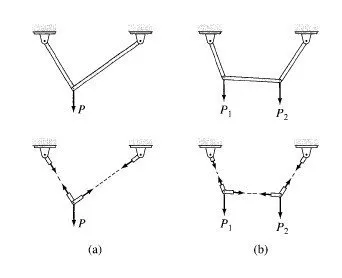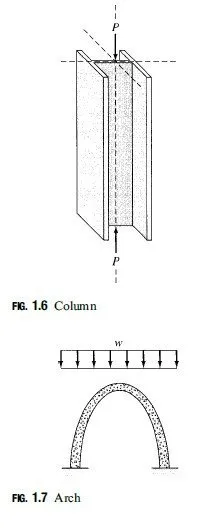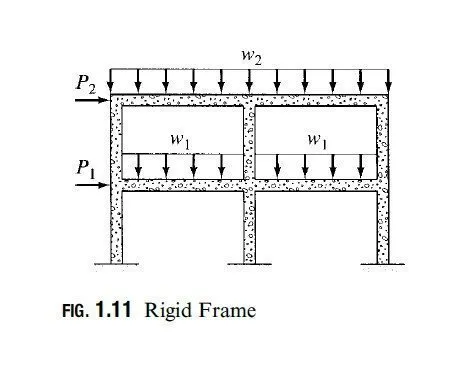As discussed in the preceding section, perhaps the most important decision made by a structural engineer in implementing an engineering project is the selection of the type of structure to be used for supporting or transmitting loads. Commonly used structures can be classified into five basic categories, depending on the type of primary stresses that may develop in their members under major design loads. However, it should be realized that any two or more of the basic structural types described in the following may be combined in a single structure, such as a building or a bridge, to meet the structures functional requirements.
Tension Structures
The members of tension structures are subjected to pure tension under the action of external loads. Because the tensile stress is distributed uniformly over the cross-sectional areas of members, the material of such a structure is utilized in the most e°cient manner. Tension structures composed of flexible steel cables are frequently employed to support bridges and long-span roofs. Because of their flexibility, cables have negligible bending sti¤ness and can develop only tension. Thus, under external loads, a cable adopts a shape that enables it to support the load by tensile forces alone. In other words, the shape of a cable changes as the loads acting on it change. As an example, the shapes that a single cable may assume under two di¤erent loading conditions are shown in Fig. 1.3. Figure 1.4 shows a familiar type of cable structure the suspension bridge. In a suspension bridge, the roadway is suspended from two main cables by means of vertical hangers. The main cables pass over a pair of towers and are anchored into solid rock or a concrete foundation at their ends. Because suspension bridges and other cable structures lack sti¤ness in lateral directions, they are susceptible to wind-induced oscillations (see Fig. 1.5). Bracing or sti¤ening systems are therefore provided to reduce such oscillations. Besides cable structures, other examples of tension structures include vertical rods used as hangers (for example, to support balconies or tanks) and membrane structures such as tents.
Compression Structures
Compression structures develop mainly compressive stresses under the action of external loads. Two common examples of such structures are columns and arches. Columns are straight members subjected to axially compressive loads, as shown in Fig. 1.6. When a straight member is subjected to lateral loads and/or moments in addition to axial loads, it is called a beam-column. An arch is a curved structure, with a shape similar to that of an inverted cable, as shown in Fig. 1.7. Such structures are frequently used to support bridges and long-span roofs. Arches develop mainly compressive stresses when subjected to loads and are usually designed so that they will develop only compression under a major design loading. However, because arches are rigid and cannot change their shapes as can cables, other loading conditions usually produce secondary bending and shear stresses in these structures, which, if significant, should be considered in their designs. Because compression structures are susceptible to buckling or instability, the possibility of such a failure should be considered in their designs; if necessary, adequate bracing must be provided to avoid such failures.
Trusses
Trusses are composed of straight members connected at their ends by hinged connections to form a stable configuration (Fig. 1.8). When the loads are applied to a truss only at the joints, its members either elongate or shorten. Thus, the members of an ideal truss are always either in uniform tension or in uniform compression. Real trusses are usually constructed by connecting members to gusset plates by bolted or welded connections. Although the rigid joints thus formed cause some bending in the members of a truss when it is loaded, in most cases such secondary bending stresses are small, and the assumption of hinged joints yields satisfactory designs. Trusses, because of their light weight and high strength, are among the most commonly used types of structures. Such structures are used in a variety of applications, ranging from supporting roofs of buildings to serving as support structures in space stations.
Shear Structures
Shear structures, such as reinforced concrete shear walls (Fig. 1.9), are used in multistory buildings to reduce lateral movements due to wind loads and earthquake excitations. Shear structures develop mainly inplane shear, with relatively small bending stresses under the action of external loads.
Bending Structures
Bending structures develop mainly bending stresses under the action of external loads. In some structures, the shear stresses associated with the changes in bending moments may also be significant and should be considered in their designs. Some of the most commonly used structures, such as beams, rigid frames, slabs, and plates, can be classified as bending structures. A beam is a straight member that is loaded perpendicular to its longitudinal axis (Fig. 1.10). Recall from previous courses on statics and mechanics of materials that the bending (normal) stress varies linearly over the depth of a beam from the maximum compressive stress at the fiber farthest from the neutral axis on the concave side of the bent beam to the maximum tensile stress at the outermost fiber on the convex side. For example, in the case of a horizontal beam subjected to a vertically downward load, as shown in Fig. 1.10, the bending stress varies from the maximum compressive stress at the top edge to the maximum tensile stress at the bottom edge of the beam. To utilize the material of a beam cross section most e°ciently under this varying stress distribution, the cross sections of beams are often I-shaped (see Fig. 1.10), with most of the material in the top and bottom flanges. The I-shaped cross sections are most e¤ective in resisting bending moments.
Rigid frames are composed of straight members connected together either by rigid (moment-resisting) connections or by hinged connections to form stable configurations. Unlike trusses, which are subjected only to joint loads, the external loads on frames may be applied on the members as well as on the joints (see Fig. 1.11). The members of a rigid frame are, in general, subjected to bending moment, shear, and axial compression or tension under the action of external loads. However, the design of horizontal members or beams of rectangular frames is often governed by bending and shear stresses only, since the axial forces in such members are usually small. Frames, like trusses, are among the most commonly used types of structures. Structural steel and reinforced concrete frames are commonly used in multistory buildings (Fig. 1.12), bridges, and industrial plants. Frames are also used as supporting structures in airplanes, ships, aerospace vehicles, and other aerospace and mechanical applications. It may be of interest to note that the generic term framed structure is frequently used to refer to any structure composed of straight members, including a truss. In that context, this textbook is devoted primarily to the analysis of plane framed structures.









